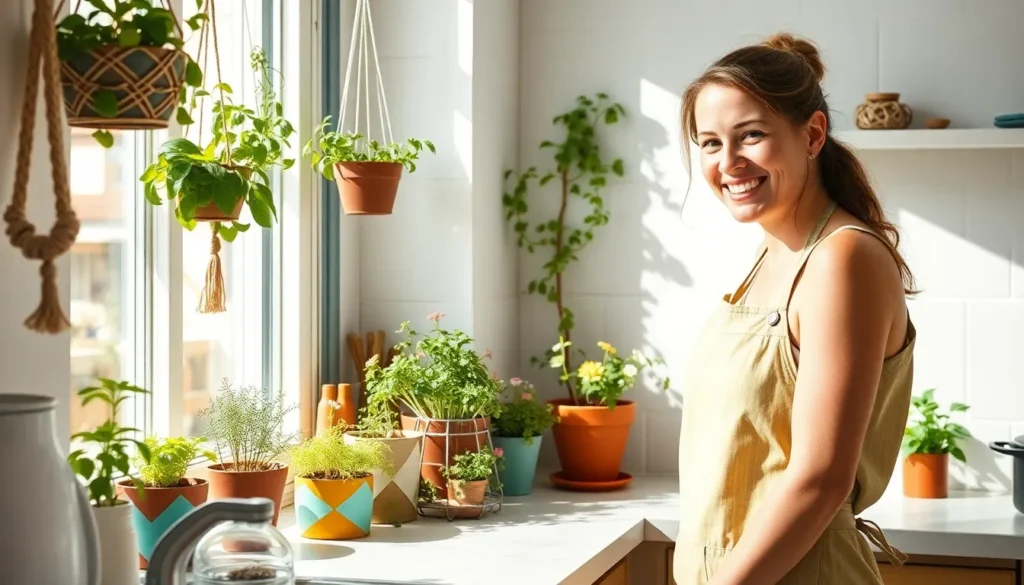We’ve all walked into a kitchen and felt something was missing – that spark of life that transforms a cooking space from sterile to stunning. The secret? Strategic plant placement that brings nature indoors while serving practical purposes beyond mere decoration.
Kitchen plants aren’t just trendy additions to your Instagram feed. They’re powerful allies that purify air while you cook, provide fresh herbs at your fingertips, and create an inviting atmosphere that makes meal prep feel less like a chore. From compact succulents perched on windowsills to trailing pothos cascading from upper cabinets, the right greenery can revolutionize your culinary sanctuary.
Whether you’re working with a tiny apartment galley or a sprawling chef’s paradise, we’ll show you how to select plants that thrive in kitchen conditions while maximizing both form and function. Get ready to transform your cooking space into a vibrant, living environment that nourishes both body and soul.
Herb Gardens That Transform Your Kitchen Into a Culinary Paradise
Fresh herbs within arm’s reach revolutionize our daily cooking experience while adding natural beauty to the kitchen space.
Fresh Basil and Oregano Window Displays
Window sill herb gardens featuring basil and oregano create aromatic focal points that capture natural sunlight. We recommend placing 4-6 inch pots along south-facing windows where these Mediterranean herbs receive 6-8 hours of direct sunlight daily. Sweet basil varieties like Genovese and Thai basil thrive in warm, bright conditions while oregano spreads beautifully across wider containers.
Cascading oregano stems create stunning visual displays when planted in hanging window planters. The herbs’ different textures complement each other perfectly – basil’s broad, glossy leaves contrast beautifully with oregano’s small, textured foliage. We’ve found that rotating the pots weekly ensures even growth and prevents herbs from leaning toward the light source.
Vertical Herb Wall Installations
Wall-mounted herb gardens maximize growing space in compact kitchens while creating living artwork. We install modular pocket planters or mason jar systems on unused wall areas near prep zones. These vertical systems accommodate 8-12 different herb varieties including rosemary, thyme, sage, and cilantro.
Professional installations using rail systems allow us to adjust planter heights and positions seasonally. The vertical approach keeps frequently used herbs at eye level while positioning slower-growing varieties like rosemary higher up. Drip irrigation systems can be integrated into these walls to maintain consistent moisture without creating water damage.
Countertop Herb Garden Containers
Portable container gardens bring herbs directly to our cooking workspace without permanent installation. We use rectangular planters that fit along backsplashes or circular arrangements that serve as centerpieces on kitchen islands. Terra cotta, ceramic, and food-safe plastic containers all work effectively for different aesthetic preferences.
Three-tier herb stands maximize countertop growing space while maintaining easy access to each plant level. These systems work particularly well for herbs with different height requirements – parsley and chives on lower levels, larger herbs like rosemary on top tiers. We ensure adequate drainage by placing saucers under each container to protect countertop surfaces from water stains.
Hanging Plant Solutions That Maximize Kitchen Space
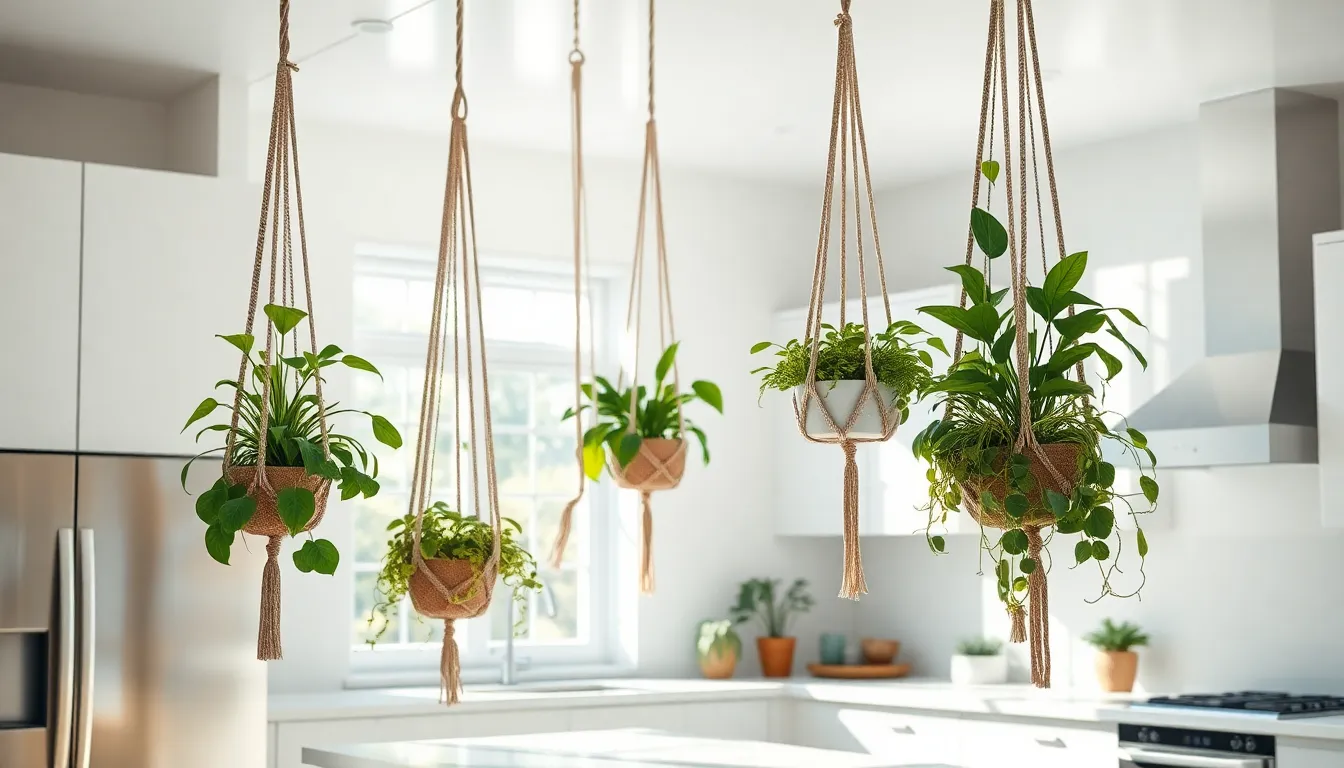
When counter space is precious and you’re craving more greenery, vertical plant displays offer the perfect solution. These elevated approaches transform unused ceiling areas into thriving garden zones while keeping your workspace clear.
Macrame Plant Hangers Above Islands
Macrame plant hangers create stunning focal points when suspended above kitchen islands, combining bohemian charm with practical functionality. These handwoven cotton rope hangers typically measure 44 to 54 inches long and safely support plants weighing up to 10 pounds when properly installed with ceiling hooks.
We recommend choosing DIY macrame kits that include jute or cotton cord, scissors, and installation hardware for a personalized touch. Popular options feature wooden shelves or decorative metal rings that accommodate multiple small plants or trailing varieties like pothos and spider plants.
Installation requires sturdy ceiling hooks positioned directly above your island to ensure plants receive adequate light without interfering with food preparation. The natural texture of macrame adds warmth to modern kitchens while creating vertical interest that draws the eye upward.
Ceiling-Mounted Pot Racks with Trailing Plants
Ceiling mounted pot racks traditionally designed for cookware storage become innovative plant display systems when repurposed for trailing greenery. These versatile fixtures use overhead space above work areas while combining storage functionality with living decoration.
We suggest selecting racks with multiple hanging points to accommodate various pot sizes and plant types. Popular trailing options include English ivy, string of hearts, and philodendrons that cascade beautifully while improving air quality in your cooking space.
Position these racks strategically above prep areas where you’ll benefit most from the air purifying properties of your plants. The dual purpose design maximizes utility while creating an eye catching display that guests will admire.
Over-Sink Hanging Garden Systems
Over sink hanging garden systems transform the often underutilized space above your kitchen sink into a productive growing area. These specialized systems feature suspended shelves or multi tiered planters designed specifically for herbs, succulents, and small decorative plants.
We find these systems particularly valuable for growing fresh herbs that you’ll use frequently while cooking, keeping them within easy reach for quick harvesting. The proximity to water makes maintenance simple, and the typical bright lighting near sink areas promotes healthy plant growth.
Choose systems with adjustable heights to accommodate plants of varying sizes and growth patterns. Popular configurations include three tier designs that hold multiple small pots or single large planters perfect for herb collections like basil, parsley, and chives.
Windowsill Plant Arrangements That Brighten Your Cooking Space
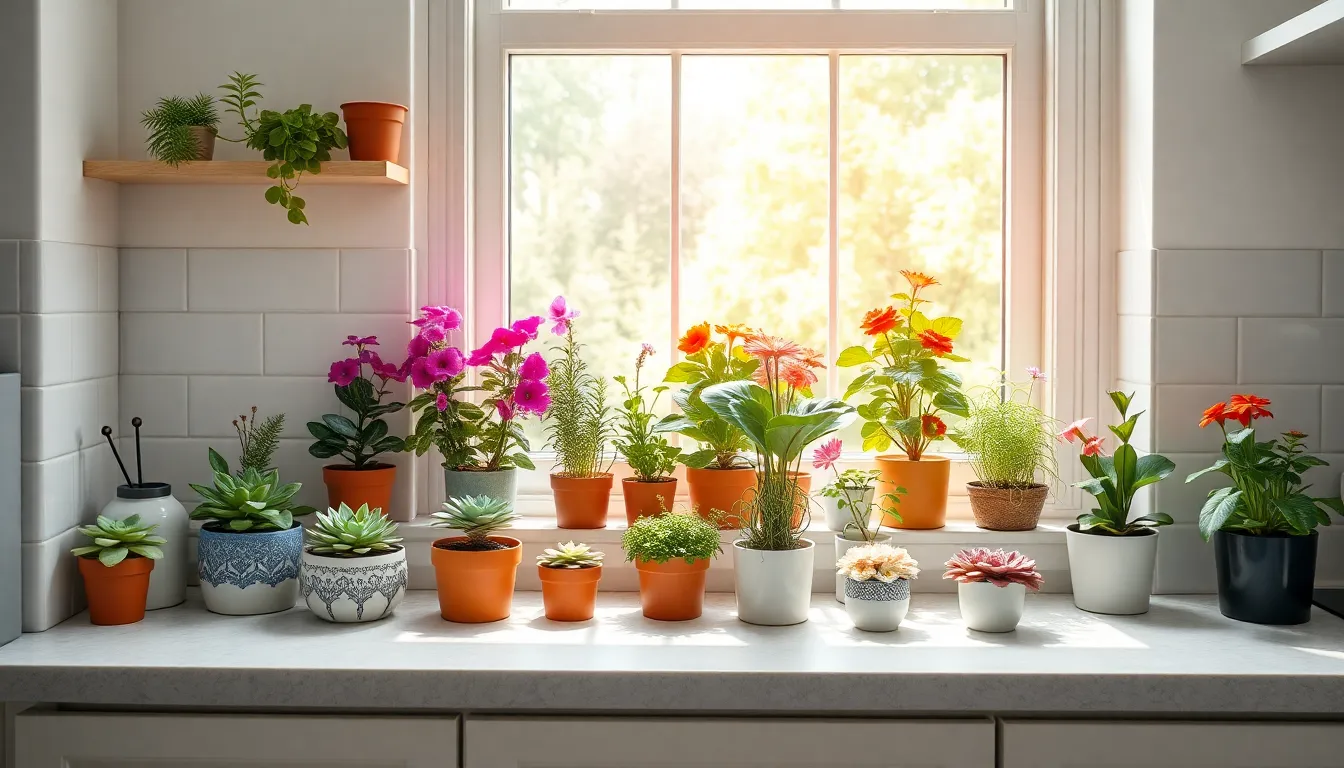
Our kitchen windowsills offer the perfect opportunity to create stunning plant displays that transform your cooking space into a vibrant, living environment. Natural sunlight streaming through windows provides ideal growing conditions for various plants that’ll enhance both the functionality and beauty of your kitchen.
Succulent Collections in Decorative Pots
Succulents make exceptional kitchen companions because they require minimal watering and care while delivering maximum visual impact. We recommend grouping several varieties like echeveria, jade plants, and string of pearls in decorative ceramic or glass pots along your windowsill. These collections create a modern, clean aesthetic that complements contemporary kitchen designs perfectly.
Ceramic pots in neutral tones or bold colors can match your kitchen’s existing color scheme, while glass containers add a sleek, minimalist touch. The low maintenance nature of succulents means you won’t need to worry about frequent watering or complex care routines, making them ideal for busy cooks who want beautiful plants without the hassle.
Small Flowering Plants for Color Accents
Small flowering plants like African violets, kalanchoe, and mini orchids introduce vibrant pops of color that enliven even the most neutral kitchen spaces. These compact bloomers thrive in the moderate sunlight that most kitchen windows provide, creating cheerful focal points throughout your cooking area.
African violets offer delicate purple, pink, or white blooms that add elegance to your windowsill display. Kalanchoe plants produce clusters of bright flowers in red, yellow, orange, or pink that last for weeks, providing long lasting color. Mini orchids bring exotic beauty with their intricate blooms, creating an upscale restaurant feel in your home kitchen.
Bright, colorful pots enhance the visual impact of these flowering plants while allowing you to coordinate with your kitchen’s design aesthetic. The combination of natural blooms and thoughtfully chosen containers creates a pleasant cooking environment that makes meal preparation more enjoyable.
Compact Vegetable Seedling Displays
Growing vegetable seedlings on your kitchen windowsill combines decoration with practicality, giving you fresh ingredients while adding green, living elements to your space. Cherry tomatoes, peppers, and lettuce seedlings thrive in sunny kitchen windows and can be arranged in small trays or individual pots for an organized, attractive display.
Starting these seedlings indoors allows you to monitor their growth closely while enjoying their fresh, green appearance as part of your kitchen decor. Small trays create neat, uniform displays that maximize your windowsill space, while individual pots offer flexibility in arrangement and easier transplanting when the plants outgrow their containers.
These compact vegetable displays prepare young plants for later outdoor transplanting or continued indoor harvesting, depending on your space and growing goals. The fresh green foliage adds natural beauty to your kitchen while promising future homegrown vegetables for your cooking adventures.
Counter-Friendly Plant Ideas That Don’t Compromise Function

Kitchen counter space is precious real estate that we can’t afford to sacrifice for plant displays. Strategic placement and smart plant choices allow us to enjoy greenery while maintaining our cooking workspace’s efficiency.
Mini Potted Plants Between Appliances
Small potted herbs like basil, parsley, cilantro, thyme, and rosemary fit perfectly in the narrow spaces between kitchen appliances. These compact plants thrive on windowsills or countertops without cluttering our workspace, providing both decoration and fresh ingredients within arm’s reach. We can grow these herbs successfully in 4-inch pots that slide easily into gaps between the coffee maker and toaster or alongside the microwave. Their minimal footprint means we don’t lose valuable prep space while gaining access to fresh seasonings that elevate our daily cooking.
Decorative Plant Stands for Corner Spaces
Corner plant stands transform unused kitchen corners into stylish green focal points without interfering with our cooking flow. These decorative stands elevate plants off the counter surface, improving both organization and light exposure for better plant health. We can position trailing plants like Heartleaf Philodendrons on corner stands where their vines cascade gracefully without blocking cabinet access or workspace pathways. Multi-tiered corner stands accommodate several small plants vertically, maximizing our plant collection while maintaining clear countertops for meal preparation.
Tiered Plant Shelving Units
Vertical tiered shelving units display multiple plants efficiently while preserving counter space for cooking tasks. These organizational answers hold combinations of herbs, trailing plants, and small decorative pots that create stunning green displays without compromising kitchen functionality. We can arrange different plant heights across the tiers, placing taller specimens on lower shelves and compact herbs or succulents on upper levels for easy access during cooking. Tiered units work particularly well against blank walls or in breakfast nook areas where they add visual interest without interrupting our primary cooking zones.
Wall-Mounted Plant Systems That Add Vertical Interest
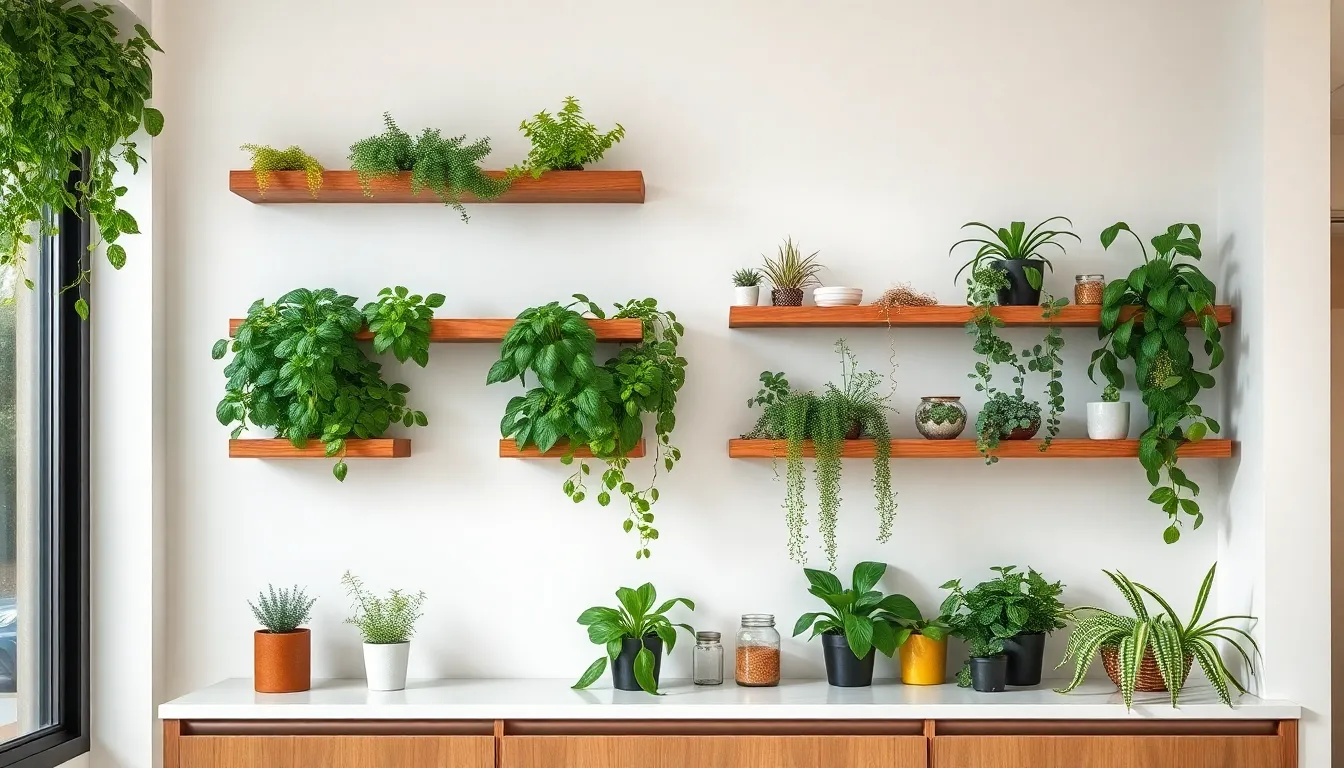
We’ve discovered that wall mounted systems offer the perfect solution for kitchens where floor space comes at a premium. These vertical answers allow us to layer plants at different heights while maximizing both light exposure and visual impact throughout our cooking spaces.
Living Wall Planters for Herbs and Greens
Living wall planters transform any kitchen wall into a productive herb garden that keeps fresh ingredients within arm’s reach. We can install these vertical gardening systems using pockets or modular containers attached to frames that mount securely on walls receiving indirect light. These systems work exceptionally well for growing basil, mint, parsley, and other common kitchen herbs that we use regularly in our cooking.
Installing a living wall requires minimal floor space while providing maximum growing potential for leafy greens and herbs. We position these planters near our prep areas so we can simply reach over and harvest fresh ingredients while cooking. The modular design allows us to expand our herb collection over time by adding more containers as our gardening confidence grows.
Floating Shelf Plant Displays
Floating shelves create clean lines that highlight our plants without visible brackets cluttering the visual space. We arrange these wall mounted shelves in staggered patterns to accommodate plants of varying sizes and textures, creating that coveted mini indoor jungle effect that energizes our kitchen environment. Rustic wood options blend beautifully with farmhouse aesthetics, while modern minimalist designs complement contemporary kitchen styles.
Multi tier floating shelves maximize our vertical growing space by allowing us to display trailing vines on upper levels and compact herb pots on lower shelves. We can arrange hexagonal floating shelves in creative geometric patterns that add depth and visual interest to otherwise plain wall spaces. These versatile shelves hold everything from small succulent collections to cascading pothos that soften hard kitchen lines.
Magnetic Planters for Refrigerator Sides
Magnetic planters attach effortlessly to our refrigerator surfaces without requiring any installation or wall mounting hardware. We use these compact containers to cultivate tiny herbs or succulents that add greenery at eye level while keeping fresh seasonings handy for cooking. These space saving answers work perfectly in galley kitchens or apartments where every inch of growing space matters.
Small magnetic pots allow us to grow single herb varieties like chives, oregano, or small basil plants that we can harvest frequently. We position these planters at comfortable heights on our refrigerator doors so we can easily tend to our plants during daily kitchen routines. The magnetic system lets us rearrange our mini garden whenever we want to refresh our kitchen’s green display.
Low-Light Plant Options Perfect for Kitchen Environments
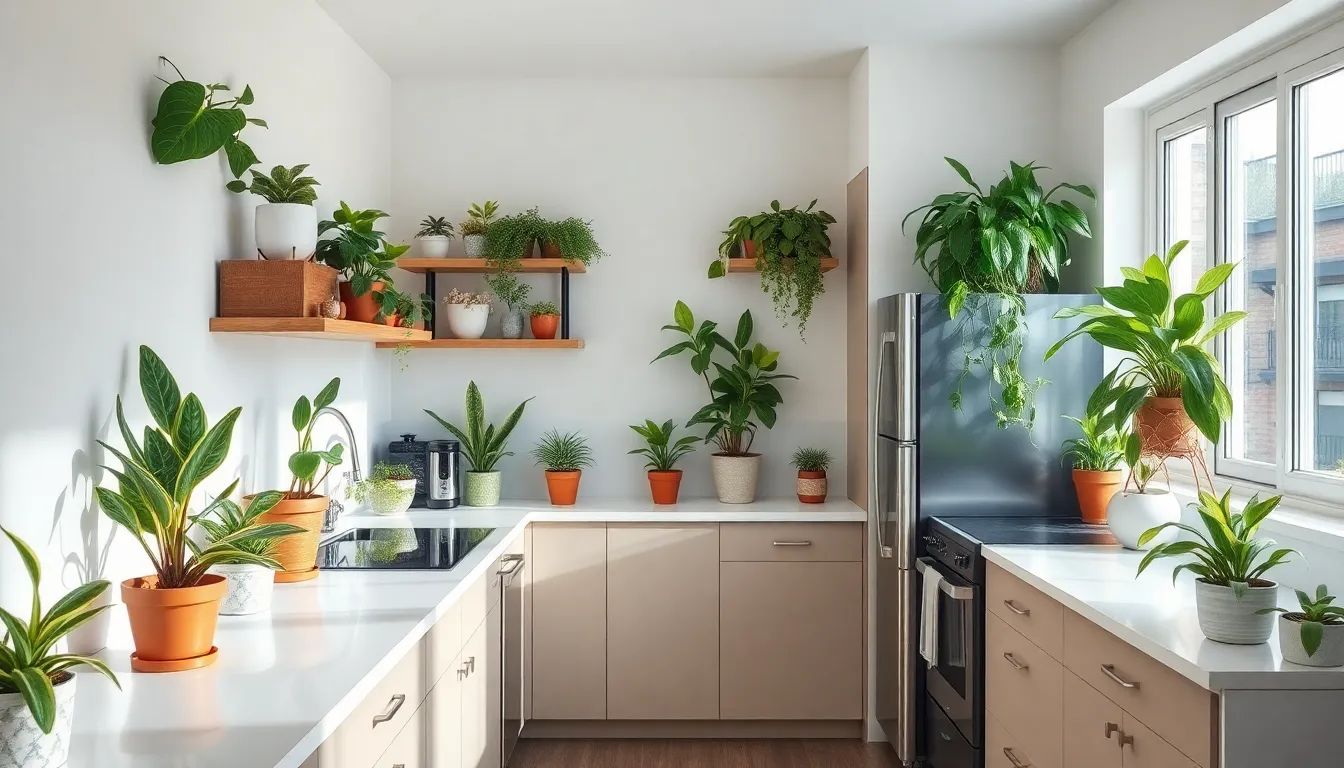
Many kitchens struggle with limited natural light, making it challenging to maintain thriving greenery. We’ve identified the perfect low-light tolerant plants that’ll flourish in these shadowy spaces while requiring minimal care.
Snake Plants for Darker Kitchen Corners
Snake plants represent the ultimate solution for kitchens with minimal lighting conditions. These resilient beauties tolerate extremely low light while requiring water only every 2-3 weeks, making them perfect for busy cooking spaces. Their sword-like leaves create striking vertical lines that complement modern kitchen designs while actively purifying indoor air.
We recommend placing snake plants in corners where other greenery would struggle to survive. Dark spaces between appliances, shadowy nooks near pantries, or areas far from windows become vibrant with these hardy specimens. Their air-purifying qualities remove toxins like formaldehyde and benzene, creating healthier cooking environments.
Varieties like Sansevieria trifasciata ‘Laurentii’ with golden edges or the compact ‘Hahnii’ bird’s nest snake plant offer different aesthetic options. Each variety maintains the same remarkable tolerance for neglect while adding sophisticated greenery to challenging kitchen locations.
Pothos Varieties That Thrive in Artificial Light
Pothos plants excel under fluorescent or LED kitchen lighting, making them ideal for spaces without abundant natural light. Golden Pothos, Marble Queen, and Neon varieties adapt beautifully to artificial illumination while creating cascading displays from upper cabinets or shelves. Their trailing vines reach lengths of 6-10 feet, transforming bare walls into living art.
We suggest positioning pothos plants on top of refrigerators, upper cabinet edges, or hanging planters above kitchen islands. Artificial lighting from under-cabinet fixtures or overhead fluorescents provides sufficient energy for healthy growth. These forgiving plants continue thriving even when natural light remains scarce throughout winter months.
Training pothos vines around cabinet frames or along wall edges creates natural borders that soften harsh kitchen lines. Regular pruning encourages fuller growth while providing cuttings for propagating new plants throughout your home.
ZZ Plants for Low-Maintenance Green Accents
ZZ plants deliver maximum impact with minimal effort, tolerating both low light and irregular watering schedules. Their glossy, dark green leaves reflect available light, brightening dim kitchen corners while requiring water only when soil completely dries out. This drought tolerance makes them perfect for travelers or anyone with inconsistent plant care routines.
We place ZZ plants on counter edges, window ledges with northern exposure, or shelving units where direct sunlight never reaches. Their modern, architectural appearance complements contemporary kitchen designs while adding sophisticated greenery to utilitarian spaces. Mature plants reach 2-3 feet tall, creating substantial presence without overwhelming compact kitchens.
ZZ plants purify air by removing volatile organic compounds commonly found in kitchen environments. Their waxy leaves require occasional dusting but otherwise thrive on neglect, making them excellent choices for first-time plant parents or busy households seeking effortless greenery.
Edible Plant Ideas That Serve Dual Kitchen Purposes
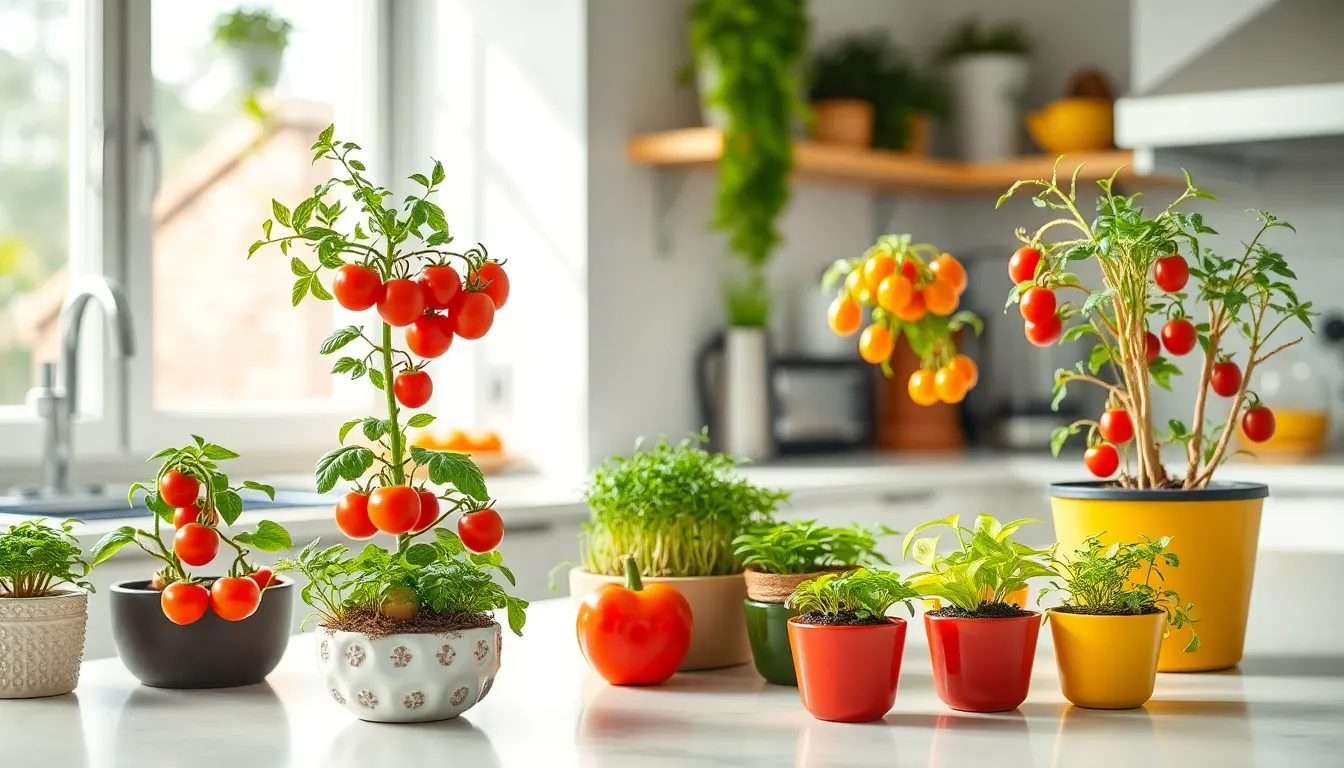
Beyond traditional herbs and decorative houseplants, we can transform our kitchens with edible plants that serve multiple purposes. These versatile additions provide fresh ingredients while improving our kitchen’s visual appeal and functionality.
Cherry Tomato Plants in Decorative Containers
Cherry tomato plants bring vibrant color and fresh produce directly to our kitchen spaces. These compact plants thrive in decorative containers, with varieties like “Yellow Pear” tomatoes creating stunning visual displays in striking yellow and cobalt colored pots. We can enhance their aesthetic appeal by surrounding these tomato plants with companion flowers like melampodium, which adds extra beauty to our kitchen or patio setup.
Container gardens featuring cherry tomatoes require minimal space while delivering maximum impact. The plants produce bite sized fruits perfect for quick snacking or adding fresh flavor to our daily meals. Their glossy green foliage provides natural decoration, while the bright red or yellow fruits create colorful focal points that rival any traditional houseplant.
Microgreen Growing Stations
Microgreen growing stations offer one of the fastest ways to cultivate fresh cooking ingredients in our kitchens. These dedicated growing setups fit perfectly on kitchen counters or shelves, providing quick access to nutrient dense garnishes and cooking ingredients. We can harvest these young plants within days of planting, ensuring a constant supply of fresh greens for our culinary creations.
Setting up microgreen stations requires minimal equipment but delivers maximum nutrition and flavor. Popular varieties like pea shoots, radish greens, and sunflower microgreens grow rapidly in shallow containers with proper drainage. Their compact growing requirements make them ideal for small kitchen spaces where every inch counts.
Small Pepper Plants for Fresh Cooking Ingredients
Small pepper plants deliver fresh spice and heat directly from our kitchen gardens to our cooking preparations. These compact plants grow beautifully in small pots or containers designed for kitchen spaces, adding both greenery and functional ingredients to our culinary arsenal. We can choose from mild varieties like sweet peppers or spicier options depending on our taste preferences and cooking needs.
Growing pepper plants indoors provides year round access to fresh capsicums without relying on store bought options. Their attractive foliage and colorful fruits serve dual purposes as living decoration and practical cooking ingredients. The plants require similar care to cherry tomatoes, making them perfect companions in our edible kitchen garden collection.
Plant Care Tips Specifically for Kitchen Environments
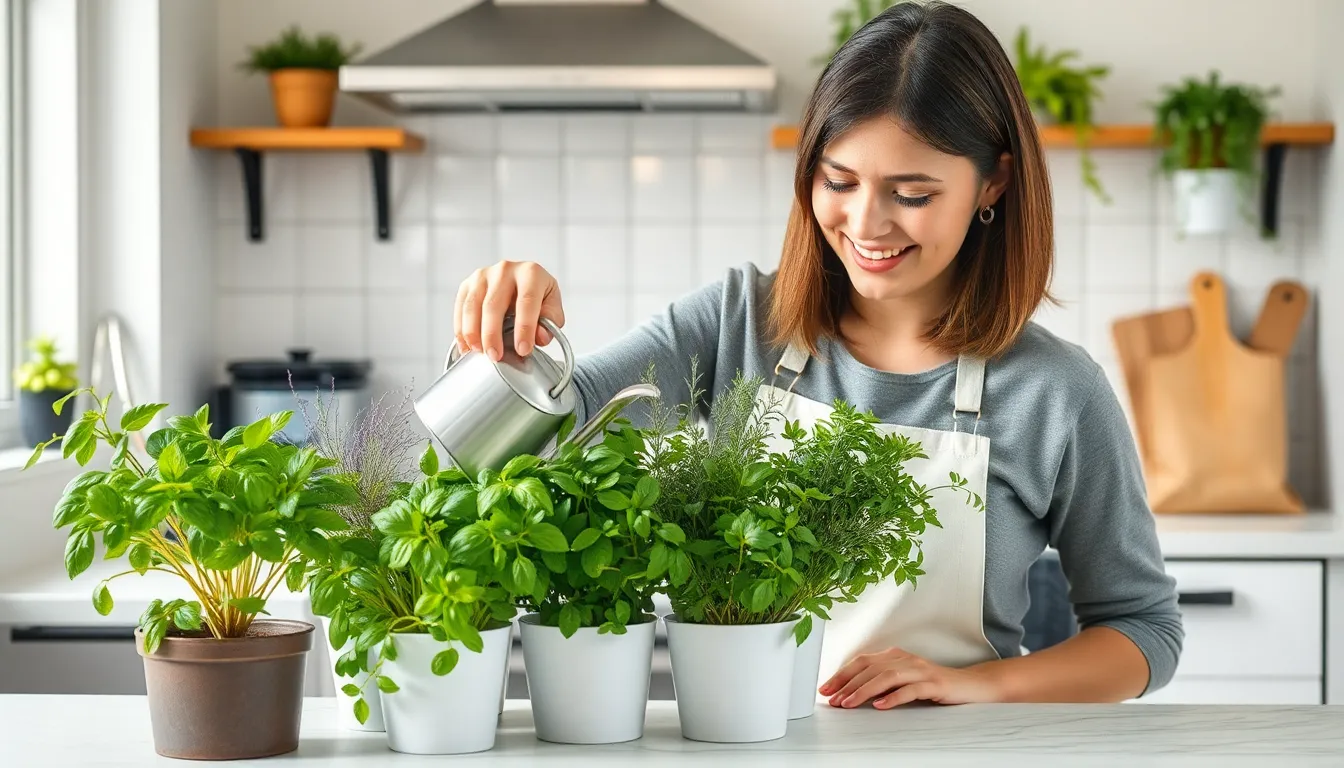
Success with kitchen plants requires understanding how cooking activities affect plant health. We’ve learned that strategic care adjustments help our green companions thrive alongside our culinary adventures.
Managing Humidity from Cooking Activities
Kitchens naturally create variable humidity levels from cooking steam and boiling water, which can actually benefit many plants when managed properly. Most kitchen plants like herbs including rosemary, basil, tarragon, oregano, marjoram, thyme, parsley, and chives tolerate moderate humidity well and even appreciate occasional steam from cooking.
Excessive steam or heat can damage delicate leaves, so we need to position plants thoughtfully. Placing plants away from direct steam sources prevents leaf damage while still allowing them to benefit from ambient moisture. Drying out the soil properly between watering sessions becomes crucial in humid environments to prevent root rot caused by excess environmental moisture.
Protecting Plants from Heat and Steam
Heat and steam from cooking appliances create stress that can damage our kitchen plants if we don’t take protective measures. Avoiding placement directly on windowsills where heat gets trapped or next to stovetops where steam and heat intensify helps prevent plant stress and leaf damage.
Well ventilated areas away from extreme temperature fluctuations provide the ideal environment for kitchen plants. Using barriers like cardboard between plants and glass windows during very cold weather offers additional protection. Maintaining a cool, sunny spot ensures our plants receive adequate light without exposure to damaging heat sources.
Watering Schedules That Work with Kitchen Routines
Aligning watering schedules with existing kitchen activities makes plant care effortless and consistent. Establishing a weekly habit like watering tropical kitchen plants right after kitchen cleanup once a week creates a sustainable routine, while watering succulents and cacti every other week prevents overwatering.
Linking plant care to established routines such as laundry day or grocery shopping helps maintain consistency without adding extra burden to our schedules. Setting up simple watering stations near the plants removes barriers and streamlines care efforts. Reusing cooled pasta water or other cooking water provides nutrients while reducing waste, making plant care an integrated part of our kitchen activities.
Stylish Planter Ideas That Match Kitchen Decor
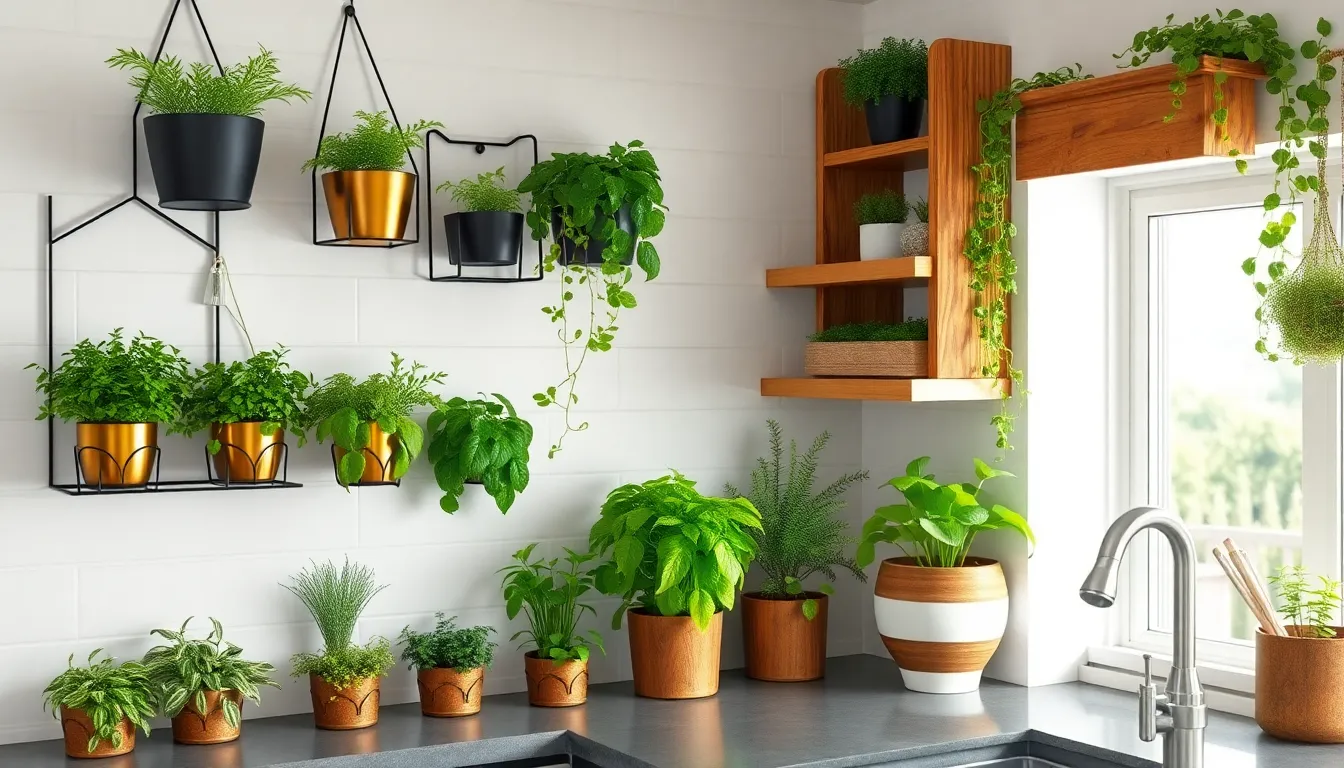
Selecting planters that complement your kitchen’s design style creates a cohesive and polished look. We’ll explore three distinct planter styles that transform functional plant displays into stunning decorative elements.
Modern Geometric Planters for Contemporary Kitchens
Geometric planters with clean lines and angular shapes elevate contemporary kitchen designs. These striking containers feature hexagonal, triangular, or polygonal forms crafted from ceramic, metal, or wood with sleek finishes. Angular designs create visual contrast against organic plant forms, making your greenery pop in minimalist spaces.
Black and gold metal wall mounted planters offer sophisticated style for modern kitchens. We recommend choosing geometric sets to create ever-changing displays that complement stainless steel appliances and quartz countertops. Ceramic pots with geometric patterns add texture while maintaining the clean aesthetic that contemporary designs demand.
Wall mounted options maximize counter space while delivering bold visual impact. Position these planters at varying heights to create artistic arrangements that serve as living wall art. Metal finishes in brushed steel or matte black integrate seamlessly with modern hardware and fixtures.
Rustic Wooden Containers for Farmhouse Styles
Wooden planter containers bring natural warmth and artisanal charm to farmhouse kitchens. Reclaimed wood boxes and lightly finished wooden crates harmonize beautifully with wooden cabinetry and farmhouse sinks. These containers emphasize the cozy, handcrafted feel that defines rustic kitchen design.
Reclaimed wood planters add authentic character while supporting sustainable design choices. We suggest using weathered wooden crates for herb gardens that complement butcher block countertops and open shelving. Natural wood grain patterns create visual interest without overwhelming traditional country kitchen elements.
Wooden boxes work perfectly for growing kitchen herbs like basil, rosemary, and thyme. Position these containers on open shelves or windowsills where natural light enhances both plant growth and wood patina. Lightly finished wooden planters develop beautiful aging that increases their rustic appeal over time.
Ceramic and Terra Cotta Options for Traditional Designs
Ceramic and terra cotta planters provide classic appeal for traditional and Mediterranean style kitchens. Their natural earthy tones and handcrafted textures add authentic charm that complements tile backsplashes and vintage accents. Terra cotta offers excellent root breathability, making these containers ideal for growing kitchen herbs.
Terra cotta pots deliver superior plant health benefits while maintaining timeless aesthetic appeal. We recommend these natural clay containers for herbs that prefer well draining soil conditions. Earthy tones blend seamlessly with warm wood cabinets and natural stone surfaces found in traditional kitchen designs.
Glazed ceramic pots come in various colors and patterns that coordinate with existing kitchen elements. Choose colors that echo your backsplash tiles or cabinet hardware for cohesive design integration. Handcrafted ceramic planters add artisanal touches that enhance the authentic feel of traditional kitchen spaces.
Budget-Friendly Kitchen Plant Solutions
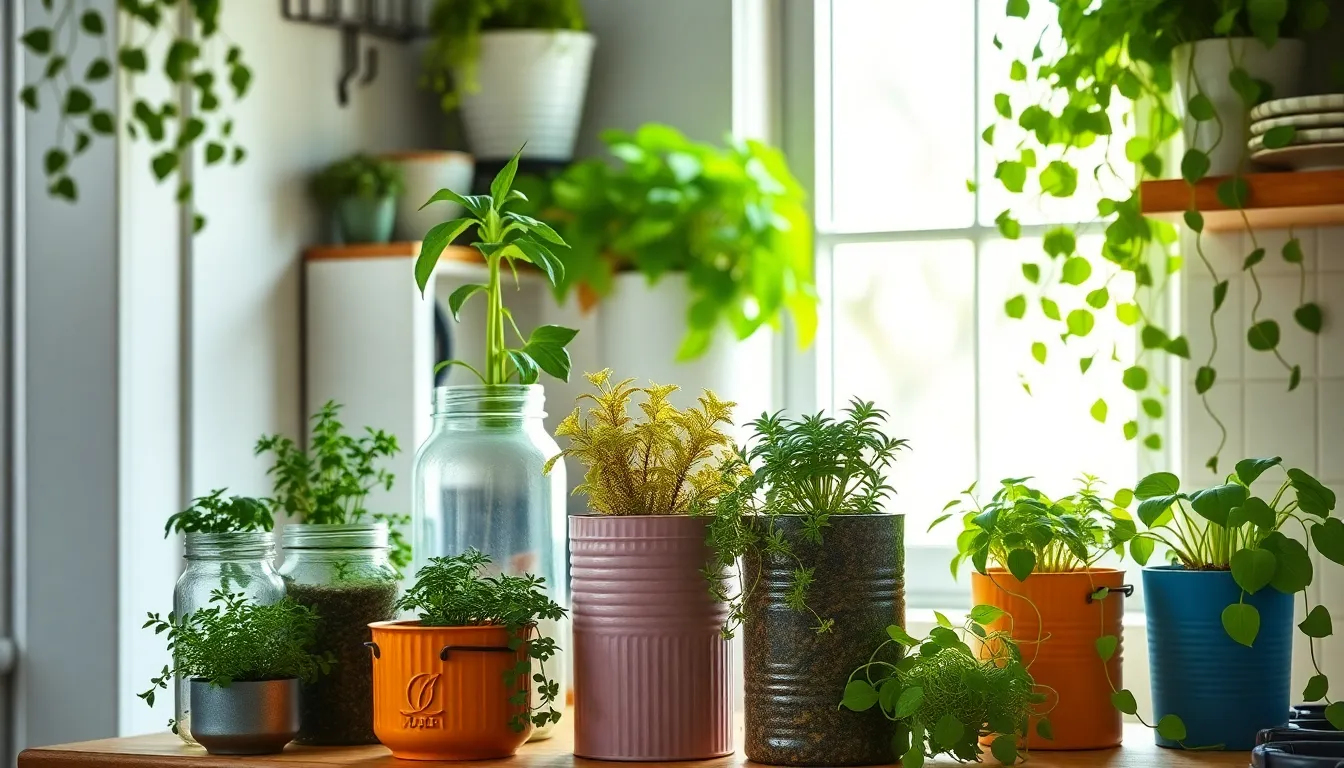
Creating a lush kitchen garden doesn’t require very costly when you know which plants and strategies deliver maximum impact for minimal investment.
DIY Planter Projects Using Recycled Materials
Repurposing everyday kitchen items transforms waste into charming planters while saving money on expensive containers. Mason jars become perfect vessels for herbs and small plants, offering clear visibility of root development and water levels. Tin cans from your pantry create industrial style planters when painted or wrapped with natural materials like twine or burlap.
Teacups and old mugs make delightful miniature planters for succulents or air plants, adding personality to windowsills and countertops. Wooden boxes from wine shipments or fruit deliveries provide rustic charm when lined with plastic and filled with drainage materials. Old colanders work exceptionally well as hanging planters since they already have built in drainage holes.
Plastic yogurt containers painted with chalk paint offer a modern aesthetic while keeping costs near zero. Even worn out boots or shoes can become whimsical planters for larger herbs like rosemary or sage.
Propagating Plants for Free Kitchen Greenery
Plant propagation multiplies your kitchen garden without spending additional money on new plants. Pothos cuttings root easily in water glasses placed on sunny windowsills, creating new plants within weeks. Simply cut 4 to 6 inch stems below leaf nodes and place them in clean water, changing it every few days.
Philodendron varieties propagate just as readily, producing roots in water before transplanting to soil filled containers. Spider plants naturally produce baby plantlets that can be rooted while still attached to the mother plant, then separated once established. Green onions regrow from their root ends when placed in water, providing continuous harvests for cooking.
Basil stems root quickly in water, allowing you to create multiple plants from a single grocery store purchase. Mint spreads rapidly through runners, making it easy to divide established plants into several new containers. Herbs like oregano and thyme can be propagated from softwood cuttings taken in spring or early summer.
Affordable Plant Varieties That Make Big Impact
Selecting the right plants ensures maximum visual appeal without premium prices typically associated with exotic varieties. Heartleaf Philodendron costs between $10 to $15 and provides lush heart shaped foliage that thrives in indirect kitchen light. These climbing plants create dramatic displays when allowed to trail from shelves or cabinets.
Money Trees range from $10 to $30 and bring both aesthetic beauty and symbolic good fortune to kitchen spaces while requiring minimal watering. Snake plants survive in low light conditions and need watering only every two to three weeks, making them perfect for busy households. Aloe Vera plants serve dual purposes by providing natural burn remedy for kitchen accidents while adding sculptural interest to countertops.
Bird’s Nest Ferns create lush tropical appeal with their glossy fronds that naturally collect and hold moisture from cooking steam. Golden Pothos varieties cascade beautifully from hanging baskets or high shelves, tolerating various light conditions and occasional neglect. These plants typically cost under $20 and grow rapidly, filling spaces with verdant foliage within months of planting.
Conclusion
We’ve explored countless ways to bring life into your kitchen space through thoughtful plant selection and creative placement. From herb gardens that enhance your cooking to air-purifying plants that improve your health these green additions transform any kitchen into a vibrant functional space.
The beauty of kitchen plants lies in their versatility. Whether you’re working with a spacious kitchen or a compact apartment there’s always room for greenery. From windowsill succulents to hanging planters to vertical gardens you can customize your approach to fit your lifestyle and space constraints.
Remember that successful kitchen gardening doesn’t require a large budget or extensive experience. With simple DIY projects affordable plant varieties and basic care knowledge you can create the kitchen oasis you’ve always wanted while enjoying fresh herbs and cleaner air every day.
Frequently Asked Questions
What are the main benefits of having plants in the kitchen?
Kitchen plants offer multiple benefits beyond aesthetics. They purify the air by filtering toxins, provide fresh herbs and ingredients for cooking, and create a welcoming atmosphere that makes meal preparation more enjoyable. Plants also contribute to better physical and emotional well-being by reducing stress and improving air quality in your cooking space.
Which herbs are best for windowsill gardens?
Basil and oregano are excellent choices for windowsill herb gardens as they thrive in bright, sunny conditions. These herbs can be displayed in decorative pots or hanging planters and provide fresh seasonings within arm’s reach. Both herbs are easy to maintain and add wonderful fragrance to your kitchen space.
How can I maximize plant space in a small kitchen?
Consider vertical solutions like hanging planters, wall-mounted systems, and tiered shelving units. Macrame hangers above kitchen islands, ceiling-mounted pot racks, and over-sink hanging gardens utilize unused space efficiently. You can also place small potted herbs in narrow gaps between appliances and use magnetic planters on refrigerator sides.
What plants work well in low-light kitchen conditions?
Snake plants, pothos varieties, and ZZ plants are perfect for darker kitchen areas. Snake plants thrive with minimal water and purify air effectively. Pothos adapts well to artificial light and creates beautiful cascading displays. ZZ plants require very little maintenance while providing consistent greenery in low-light conditions.
Which edible plants are suitable for kitchen growing?
Cherry tomato plants in decorative containers provide fresh produce and vibrant color. Microgreen growing stations offer quick access to nutrient-dense garnishes that can be harvested within days. Small pepper plants add fresh spice to cooking and require minimal space while providing year-round access to fresh ingredients.
How do I care for plants in a kitchen environment?
Manage humidity from cooking steam by positioning plants thoughtfully to avoid excessive heat damage. Align watering schedules with your kitchen routines for easier maintenance. Use cooled cooking water to nourish plants, which reduces waste and provides nutrients. Monitor plants regularly as kitchen conditions can change throughout the day.
What are some budget-friendly ways to add plants to my kitchen?
Create DIY planters using recycled materials like mason jars, tin cans, teacups, and old colanders. Use plant propagation techniques to multiply your greenery for free with easy-to-propagate plants like pothos, philodendron, and basil. Choose affordable varieties like heartleaf philodendron, snake plants, and aloe vera for maximum impact.
How do I choose planters that match my kitchen style?
For modern kitchens, select geometric planters with clean lines. Rustic wooden containers complement farmhouse-style kitchens perfectly. Traditional designs work well with ceramic and terra cotta options. The key is selecting planters that enhance your existing decor while providing functional plant displays that create a cohesive, polished look.

